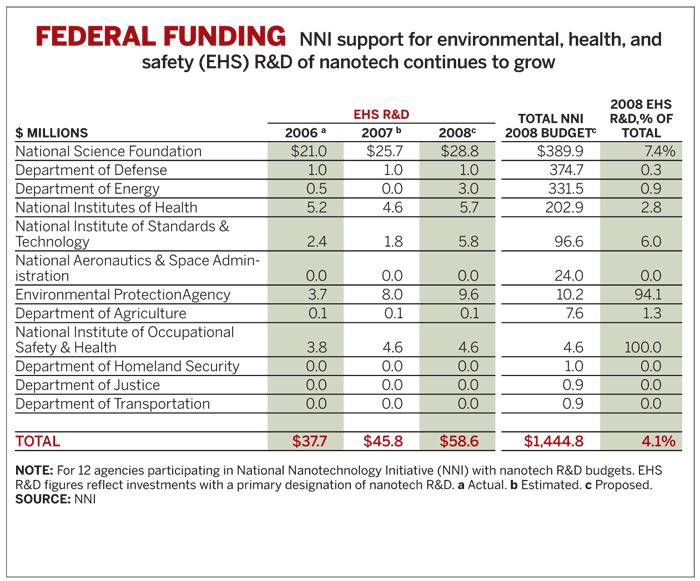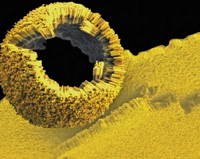Advertisement
Grab your lab coat. Let's get started
Welcome!
Welcome!
Create an account below to get 6 C&EN articles per month, receive newsletters and more - all free.
It seems this is your first time logging in online. Please enter the following information to continue.
As an ACS member you automatically get access to this site. All we need is few more details to create your reading experience.
Not you? Sign in with a different account.
Not you? Sign in with a different account.
ERROR 1
ERROR 1
ERROR 2
ERROR 2
ERROR 2
ERROR 2
ERROR 2
Password and Confirm password must match.
If you have an ACS member number, please enter it here so we can link this account to your membership. (optional)
ERROR 2
ACS values your privacy. By submitting your information, you are gaining access to C&EN and subscribing to our weekly newsletter. We use the information you provide to make your reading experience better, and we will never sell your data to third party members.
Environment
Understanding Nanotechnology
For effective rules and regulations to be set, science must play a key role
by Susan R. Morrissey
April 16, 2007
| A version of this story appeared in
Volume 85, Issue 16

WITH A GROWING NUMBER of nanotechnology-based products hitting the market, concerns about the safety of this technology are high. After all, one health or environmental scare could put an untimely end to what many experts believe is a promising field.
To guard against this fate, policymakers are doing what they can to be proactive in setting up rules and regulations to protect the public by using the best available information. Unfortunately, research that is specific to the risks of engineered nanomaterials is not keeping up with the needs of policymakers.
"Science is moving at a pace dictated by the current state of knowledge we have in the field of nanotechnology," says E. Clayton Teague, director of the National Nanotechnology Coordination Office, which supports interagency activities under the federal National Nanotechnology Initiative (NNI). But because scientific studies on the risks of nanotechnology, particularly in the area of toxicology, can take several years to complete, policymakers must make scientifically sound decisions even with little conclusive data.
"We are in this awkward middle territory where we have just enough information to think there is an issue, but not enough information to really inform policymakers about what to do about it," says Kristen M. Kulinowski, executive director of the Center for Biological & Environmental Nanotechnology at Rice University, Houston, and director of the International Council on Nanotechnology (ICON).
For example, Kulinowski points to the Environmental Protection Agency's Toxic Substances Control Act (TSCA), which is the authority currently used by the agency to regulate nanomaterials. "Some information suggests that engineered nanomaterials are toxic in certain cases and yet doesn't provide EPA with enough data to change how they are dealing with these things from a regulatory standpoint," she explains.
EPA maintains that it is doing its best with the data that's out there. "Although having robust, risk-related information would be ideal, policy development needs to occur on the basis of already available information," says Jim Willis, director of EPA's Chemical Control Division.
Willis notes that EPA has used this strategy since the mid-1970s for the new chemicals program under TSCA. He adds that future strategies for studying nanomaterials "need to include approaches for better understanding hazards and risks and integrating those data to better inform policies and regulations."
Meanwhile, "policymakers are being conservative in their estimates about the safety of nanotechnology," Teague says. This cautious attitude helps compensate for any lack of environmental, health, and safety knowledge that we currently have, he adds.
THE SCIENCE COMMUNITY for its part is moving forward. "The body of literature in this area is growing at a pretty steady pace; it's just not getting the media coverage that the initial studies in 2004 garnered," Kulinowski points out. Those 2004 studies include work showing that fish living in water containing soluble buckyballs developed brain damage (C&EN, April 5, 2004, page 14).
Even with the growing body of literature on the risks of nanomaterials—which, she notes, is being tracked by a "virtual journal" set up by ICON—one problem remains: The science community is not well-focused on any one research problem or area.
"There hasn't been a well-articulated strategic plan for determining what research needs to be done," Kulinowski says. The lack of direction has led to a situation in which "we have people who are either studying their favorite nanomaterial or studying the nanomaterial du jour," she points out.
For instance, she notes that the toxicology community is doing a lot of work on carbon nanotubes. "This is partly because they have gotten a lot of attention on the application side of nanotechnology, and it's partly because of the early studies that were done on buckyballs and fullerenes," she says.
The toxicologists' focus on carbon nanotubes demonstrates the significant autonomy that many scientists in general exercise in choosing what to do. That autonomy is a problem for setting up a robust system that effectively feeds scientific data to policymakers, says Andrew D. Maynard, chief scientist for the Project on Emerging Nanotechnologies at the Woodrow Wilson International Center for Scholars, a Washington, D.C., think tank.
"We don't have a scientific system at the moment that is really geared toward informing scientifically sound policy decisions," he says. Maynard notes that in the U.S., as in other parts of the world, science is driven by exploratory investigative research.
An exploratory-driven research system "is useful for developing new and unexpected knowledge," he says. "But if you want to understand how to use a new technology, you can't get away with what is essentially random science, hoping that someone will come up with the information you need," he points out.
Instead, Maynard asserts, a balance between exploratory and targeted research is needed. He adds that such a balance provides "a framework where science can be done that will inform policy, while exploratory research continues to discover new knowledge to feed into the targeted work."
NNI is one group that is addressing the need for targeted research on environmental, health, and safety impacts by working to develop a much-needed strategic plan. As a first step, NNI released a document in September listing 75 research needs.
According to Teague, the next step is to prioritize this list of research needs. To help with this prioritization, he notes, the White House Office of Management & Budget is doing a full assessment of the federally funded portfolio of environmental, health, and safety research.
"This assessment will tell us where the government is in terms of its current research in addressing the needs laid out in the September document," he explains. This information, along with input from all NNI agencies, will be used to prioritize research needs and allow NNI to develop a strategy to meet those needs. Teague says the final strategy will be completed this year.
IN SURVEYING the research on the risks of nanotechnology, Teague notes that scientists are becoming much more systematic in their studies than they had been, and the change is leading to higher quality work. Researchers today, he notes, are spending more time and effort on characterizing the purity of their starting materials, and they are being more careful in planning their experiments.
"A lot of the studies that got quoted in the press early on were like any initial experiments into a newly developing field—they had some inadequacies," Teague explains. For example, he points out, some studies with carbon nanotubes indicated that the material was toxic. Analysis of the starting material, however, found that the sample contained heavy metals that had been used as catalysts in the carbon nanotube production.
The impurities in the sample made it difficult to attribute experimental results to the carbon nanotubes. "There is now a significant call for higher quality, purer material when one starts an experiment in order to make sure there is a real one-to-one connection between the material and the observed effect," Teague says.
In the end, the science of nanotechnology is just one piece of ensuring that nanotechnology-based products are successful. "The public bases decisions about whether to accept technology not only on science but also on a number of other factors, including their personal beliefs," Maynard says.
"This means that even if the scientific evidence for something being good is overwhelming, people aren't necessarily going to buy into it," Maynard explains. To foster acceptance of nanotechnology as more and more products are commercialized, Maynard says, improved scientific understanding must go hand-in-hand with a dialogue between nanotechnology stakeholders and the public. "You've got to understand what motivates someone to accept or reject the technology," he says.
For now, those in the field see only minor resistance to nanotechnology from the public. "There is a simmering of public concern mainly from groups that purportedly speak for the public," Kulinowski says. She adds that the concern doesn't seem to have trickled down to the general public, which still doesn't seem to really know much about nanotechnology.
"When it does get into the public sphere," she says, "I would like for the scientific, governmental, and industrial communities to be able to say a lot more about risk than we can right now."





Join the conversation
Contact the reporter
Submit a Letter to the Editor for publication
Engage with us on Twitter